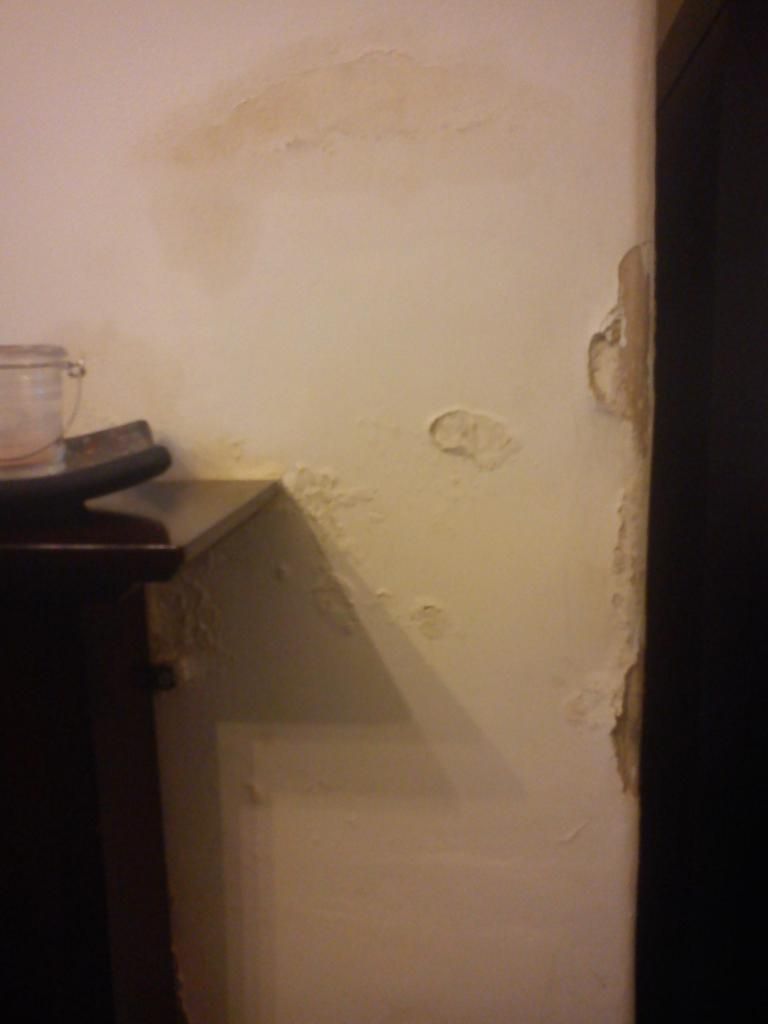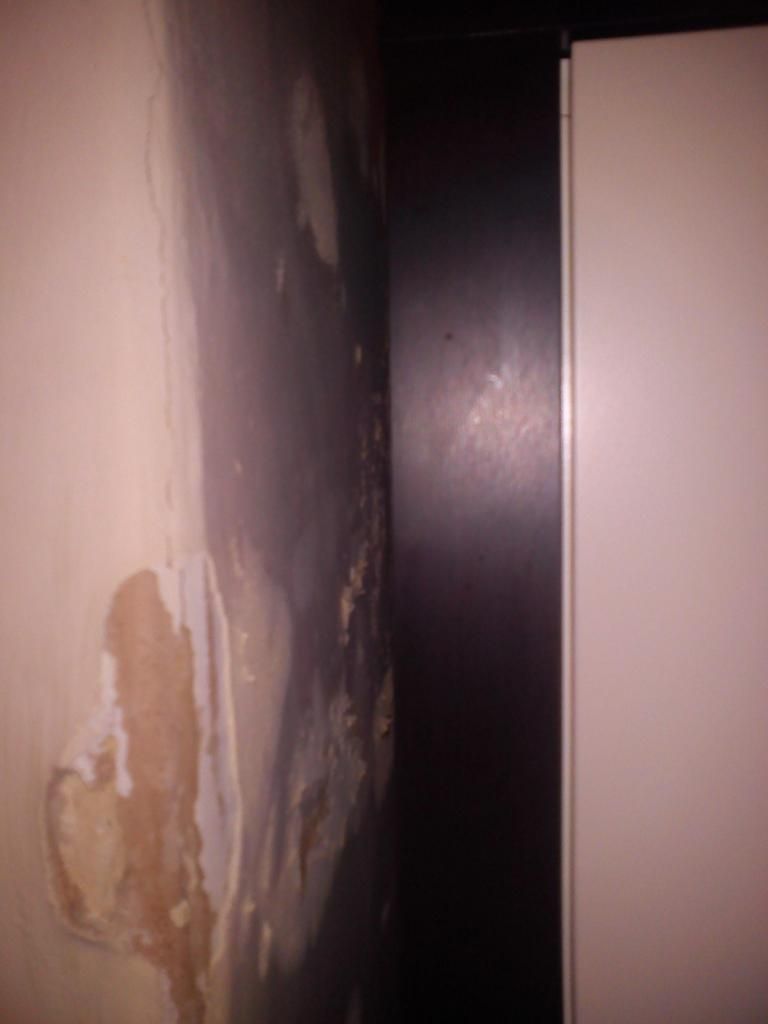We’d like to remind Forumites to please avoid political debate on the Forum.
This is to keep it a safe and useful space for MoneySaving discussions. Threads that are – or become – political in nature may be removed in line with the Forum’s rules. Thank you for your understanding.
📨 Have you signed up to the Forum's new Email Digest yet? Get a selection of trending threads sent straight to your inbox daily, weekly or monthly!
Damp Patches on Chimney Breast and paint peeling on surrounding walls (Pics)
spamberler
Posts: 622 Forumite



I bought a mid terraced house 7 years ago that had damp. I had the damp course injected where it required it. After I had mine done the next door house had theirs done (Behind Chimney Breast) and at a similar time I also had a new flueless gas fire installed. Prior to installation my dad cleared out the majority of dirt from the chimney cheeks and from what I recall sealed the sides with a concrete slab. Ever since I have had paint peeling and damp spots in and around the chimney breast. This wall wasn’t included in the damp proof but I cant tell if the cause is due to next doors having their damp proof done or if its moisture from the chimney.
Any help or advice would be much appreciated



Any help or advice would be much appreciated



A dAy WiThOuT wInE iS lIkE a DaY wItHoUt SuNsHiNe
0
Comments
-
just in case you need to know:
HWTHMBO - He Who Thinks He Must Be Obeyed (gained a promotion, we got Civil Partnered Thank you Steinfeld and Keidan)
DS#1 - my twenty-five-year old son
DS#2 - my twenty -one son0 -
Almost impossible to tell from a photo but I will stick my neck out and say possibly one of two things or maybe a combination of both.
1. Rising damp. I do not understand why they did not inject the base of the chimney breast when you had the rest of the house done.
2. Water running down the inside of the old flue. Rainwater down the flue/ defective flashings allowing water to track across into the flue/ plumbing leak above tracking across into flue etc.
I do not think it is hygroscopic salt contamination as that does not occur at the base of the flue.0 -
Almost impossible to tell from a photo but I will stick my neck out and say possibly one of two things or maybe a combination of both.
1. Rising damp. I do not understand why they did not inject the base of the chimney breast when you had the rest of the house done.
2. Water running down the inside of the old flue. Rainwater down the flue/ defective flashings allowing water to track across into the flue/ plumbing leak above tracking across into flue etc.
I do not think it is hygroscopic salt contamination as that does not occur at the base of the flue.
Thanks for that, at the time of the inspection no damp was detected around the chimney breast or the majority of walls in that room. Looking at the plans only a small area near the front door was damp.A dAy WiThOuT wInE iS lIkE a DaY wItHoUt SuNsHiNe0 -
It could be that closing up the old open fire and "sealing" the insides of the cheeks has caused the dampness to rise up and come out on the face of the chimney breast as it has been stopped from safely evapourating out at low level.
If that is the case I suspect injecting the cheeks and replastering is the only solution but should cost less than £500.0 -
ok thanks, I'll give the damp proof guys a call and get them to come and give me a quoteA dAy WiThOuT wInE iS lIkE a DaY wItHoUt SuNsHiNe0
-
What ventilation do you have in the chimney, you say the fire is flueless? Could there be any new rubbish inside the chimney (stuff that has fallen in from outside, soot from higher up)? We had 'rising damp' in a boarded up chimney breast in an old cottage, turned out inside the chimney was full of chimney crap that was bridging the old DPC and blocking up the vent.
A new DPC was advised by several companies but that would not have solved the problem because the crap would still have been bridging it: took the vent off, cleared the void out, put the vent back and it dried up beautifully. If you have water running down the inside and getting trapped at the bottom with no ventilation or escape a DPC will be useless because the issue is as much penetrating as rising IYSWIM.Declutterbug-in-progress.⭐️⭐️⭐️ ⭐️⭐️0 -
Yes it was full of 'crap' but my dad cleared it the best he could. He did leave a bit in but said, it had been there for years and hadnt caused any damp. It seems the blocking up of the chimney may have caused the issue and there isnt a vent which could also be causing a problem. That wall was tested prior to the old fire being replaced.A dAy WiThOuT wInE iS lIkE a DaY wItHoUt SuNsHiNe0
-
Could any more crap have fallen down the chimney, did you have it swept and is the top capped? IMO your main problem is lack of ventilation, chimneys are just not meant to be sealed like that. The crap will cause less of a problem if there is good air flow to keep it dry.Declutterbug-in-progress.⭐️⭐️⭐️ ⭐️⭐️0
-
I had the flue tested but not sure if it was swept. I'll dig out the paperwork and get back to you.A dAy WiThOuT wInE iS lIkE a DaY wItHoUt SuNsHiNe0
-
i would be more concerned to know what ventilation you have for the fire & how big is the room that it is installed in ?I'm only here while I wait for Corrie to start.
You get no BS from me & if I think you are wrong I WILL tell you.0
This discussion has been closed.
Confirm your email address to Create Threads and Reply

Categories
- All Categories
- 352.5K Banking & Borrowing
- 253.7K Reduce Debt & Boost Income
- 454.5K Spending & Discounts
- 245.5K Work, Benefits & Business
- 601.4K Mortgages, Homes & Bills
- 177.6K Life & Family
- 259.4K Travel & Transport
- 1.5M Hobbies & Leisure
- 16K Discuss & Feedback
- 37.7K Read-Only Boards



